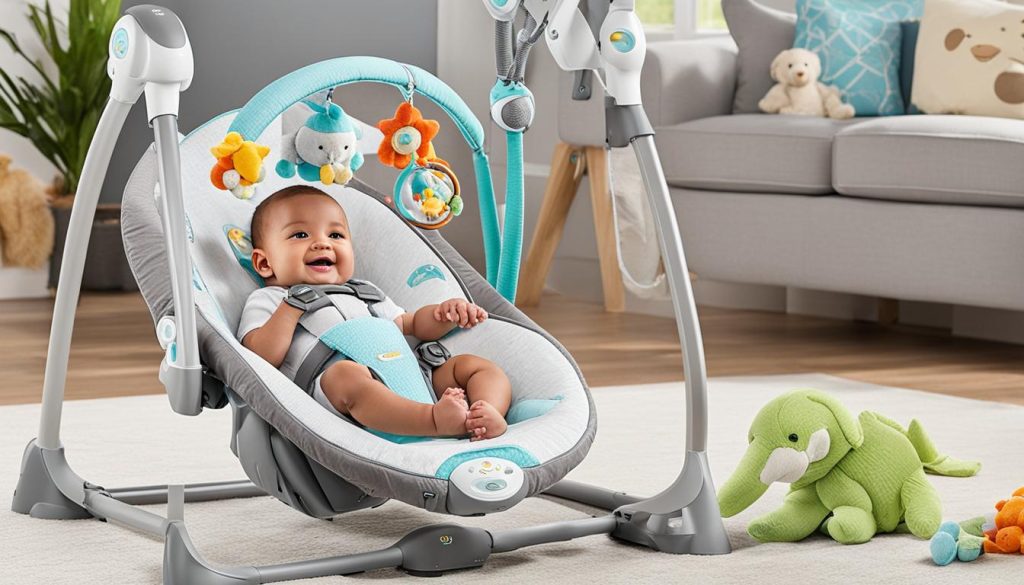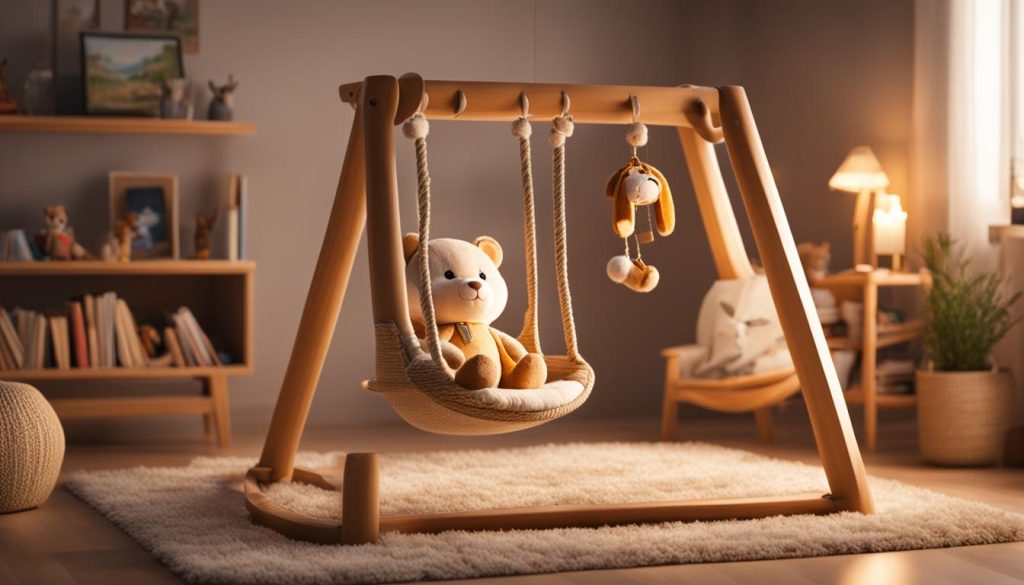Welcome to my article on determining the right age for using a baby swing. If you’re a parent or caregiver, you may have questions about when it’s appropriate to start using a baby swing for your little one. It’s essential to consider the age guidelines provided by manufacturers to ensure the safety and enjoyment of your baby.
Using a baby swing too early or too late can pose potential risks, so it’s crucial to find the right balance. In this article, I will provide an overview of the appropriate age ranges for using a baby swing, along with important guidelines to keep in mind. Let’s dive in!
Before we begin, it’s important to note that every baby is unique and may have different developmental milestones. However, there are general age recommendations that can serve as a helpful starting point in determining when to introduce a baby swing.
Stay tuned for our next section, where we’ll explore the benefits of using a baby swing for both infants and parents.
Benefits of Using a Baby Swing
Baby swings offer numerous benefits for both infants and parents. They provide a soothing and comforting motion for babies, mimicking the feeling of being rocked or held. This gentle motion can help calm a fussy baby and provide a sense of security. The repetitive back-and-forth or side-to-side motion of a baby swing has been proven to have a soothing effect on infants, helping them fall asleep and stay asleep.
Not only do baby swings soothe infants, but they also offer entertainment and stimulation. Many baby swings come with built-in toys or mobiles that capture babies’ attention and provide sensory engagement. The swinging motion combined with interesting visual stimuli can help keep babies entertained and engaged, allowing parents some much-needed rest or time to attend to other tasks.
“Using a baby swing has been a game-changer for me as a parent. It has not only provided a calming and soothing environment for my baby but has also given me a chance to catch my breath and take care of other responsibilities while knowing my baby is safe and content.”
The rest and break that baby swings offer to parents cannot be overstated. Holding and carrying a baby for long periods can be physically exhausting, especially for new parents. Baby swings provide a respite for tired arms, allowing parents to rest and recharge while their little one remains safely secured in the swing. This can be particularly beneficial during moments when parents need to tend to household chores, work from home, or simply take a moment of self-care.
Table: Benefits of Using a Baby Swing
| Benefits | Explanation |
|---|---|
| Soothing Infants | The gentle motion of a baby swing mimics being rocked, providing comfort and helping babies relax. |
| Entertaining Babies | Baby swings often come with toys or mobiles to keep babies engaged and stimulated. |
| Calming Fussy Baby | The repetitive motion of the swing can help calm a fussy baby and ease their distress. |
| Rest for Parents | Baby swings provide a break for parents, allowing them to rest their arms and attend to other tasks. |
| Soothing Motion | The gentle swinging motion of a baby swing can help lull babies to sleep and create a peaceful environment. |
Overall, using a baby swing can provide numerous benefits for both infants and parents alike. These swings offer a soothing and entertaining environment for babies, allowing them to feel secure and engaged. Meanwhile, parents can take advantage of the break and rest, knowing that their little one is safe and content. However, it’s essential to use baby swings responsibly, following safety guidelines and age recommendations provided by manufacturers.
Types of Baby Swings and Safety Features
When it comes to choosing a baby swing, there are several types available, each offering different motion types and features. Understanding the options and considering safety features is essential to ensure the well-being of your baby. Here, I will discuss the various types of baby swings and highlight important safety features to look for when selecting one.
Motion Types
One key factor to consider when choosing a baby swing is the type of motion it provides. Different swings offer different motion options, including back and forth, side to side, or a combination of both. Some swings even simulate a car ride or a gentle rocking motion. Depending on your baby’s preferences and needs, you can choose a swing with the motion type that is most soothing and calming for them.
Safety Harness and Reclining Seat
Another important feature to consider is the safety harness. A secure safety harness will keep your baby safely in place while they enjoy the swing’s motion. Look for a swing with a 5-point harness, which provides optimal support and prevents any risk of your baby slipping or falling out of the swing. Additionally, a reclining seat is crucial to ensure your baby’s comfort and support their head and neck in a safe position.
Sturdy Frame
The frame of the baby swing should be sturdy and stable to provide a secure and reliable structure. A stable frame will prevent any wobbling or tipping over, ensuring the safety of your baby. It is recommended to choose a swing with a wide base for added stability, especially if you have a more active baby who might wiggle around while using the swing.
Table: Comparison of Baby Swing Types and Safety Features
| Type of Swing | Motion Types | Safety Harness | Reclining Seat | Sturdy Frame |
|---|---|---|---|---|
| Traditional Swing | Back and forth | 5-point harness | Adjustable reclining seat | Sturdy metal frame |
| Portable Swing | Back and forth | 3-point harness | Non-adjustable seat | Lightweight frame |
| Convertible Swing | Back and forth, side to side | 5-point harness | Multiple reclining positions | Sturdy and adjustable frame |
It’s important to carefully evaluate the types of baby swings available and select one that meets your baby’s needs while providing essential safety features. By considering motion types, safety harnesses, reclining seats, and sturdy frames, you can ensure a secure and comfortable experience for your little one.
Weight and Age Limits for Baby Swings
When it comes to using a baby swing, it’s important to understand the weight and age limits set by manufacturers. These limits are in place to ensure the safety of your baby and to prevent any potential accidents. Most baby swings have a weight capacity ranging from 6 to 30 pounds, but it’s crucial to check the specific weight limits for the swing you choose.
On average, babies reach the maximum weight limit of a swing around 9 to 10 months old. It’s essential to monitor your baby’s weight and age to ensure they do not exceed the recommended limits. Exceeding the weight limit can put strain on the swing’s mechanism and compromise its stability, posing a risk to your baby’s safety.
To give you a better idea of weight limits, here are some popular baby swings and their respective weight capacities:
| Brand | Model | Weight Limit |
|---|---|---|
| Brand A | Model X | 25 pounds |
| Brand B | Model Y | 30 pounds |
| Brand C | Model Z | 20 pounds |
Remember that these weight limits are just general guidelines and may vary depending on the specific swing model. Always refer to the manufacturer’s instructions and recommendations for accurate information regarding weight limits.
Selecting the Right Baby Swing for Your Baby
Choosing a baby swing that suits your baby’s needs and preferences requires careful consideration of several factors. By taking into account safety guidelines, motion preferences, ease of use, and your budget, you can select a baby swing that provides optimal comfort and entertainment for your little one.
Safety Guidelines
When choosing a baby swing, safety should be your top priority. Look for a swing with a sturdy frame that can support your baby’s weight without any risk of tipping over. Additionally, ensure that the swing features a reliable safety harness to securely hold your baby in place. A five-point harness is recommended for maximum safety. It’s also important to follow the manufacturer’s instructions for proper setup and usage of the swing.
Motion Preferences
Consider your baby’s motion preferences when selecting a baby swing. Some swings offer back-and-forth motion, while others provide side-to-side or even multi-directional motion. Observe your baby’s reactions to different types of motion to determine which one is most soothing and comfortable for them. Keep in mind that not all babies enjoy the same type of motion, so it’s essential to choose a swing that aligns with your baby’s preferences.
Ease of Use and Budget
Take into account the ease of use and your budget when choosing a baby swing. Look for a swing that is simple to assemble, adjust, and operate. Some swings offer convenient features like removable and washable seat covers, adjustable recline positions, and built-in toys. Consider your budget and look for a swing that offers the features you need within your price range. Keep in mind that higher-priced swings may have additional features and higher weight limits.
| Factors to Consider | Safety Guidelines | Motion Preferences | Ease of Use and Budget |
|---|---|---|---|
| Sturdy frame | Secure five-point harness | Back-and-forth motion | Simple assembly and operation |
| Weight limit | Follow manufacturer’s instructions | Side-to-side motion | Adjustable recline positions |
| Comfortable seat | Multi-directional motion | Removable and washable seat covers | |
| Built-in toys |
By considering these factors and evaluating different baby swing options, you can select the perfect swing to keep your baby safe, soothed, and entertained. Remember to always supervise your baby while they are in the swing and follow the manufacturer’s guidelines for safe usage. With the right baby swing, you can provide a comfortable and enjoyable experience for your little one.
Using a Baby Swing Safely
When it comes to using a baby swing, safety should always be the top priority. Follow these essential tips to ensure a secure and enjoyable experience for your little one:
- Monitor your baby: It’s crucial to keep a close eye on your baby while they are in the swing. Never leave them unattended, even for a short period. This will help you quickly respond to their needs and ensure their safety.
- Proper use of safety harness: Always make sure to buckle your baby securely into the swing’s safety harness. This will prevent them from slipping or falling out while the swing is in motion. Check the harness regularly to ensure it is in good condition and properly adjusted.
- Supervise baby’s position: Pay attention to your baby’s position in the swing. Ensure that their head and neck are properly supported and that they are in a comfortable reclined position. Avoid using the swing if your baby cannot hold their head up on their own.
- Avoid elevated surfaces: Never place the baby swing on an elevated surface, such as a table or countertop. This can pose a serious risk of falls or tip-overs. Always place the swing on a flat, stable surface, such as the floor, and ensure that it is securely locked in place.
- Comply with manufacturer instructions: Always read and follow the manufacturer’s instructions for setting up and using the baby swing. This will ensure that you are using the swing correctly and in accordance with safety guidelines. Failure to do so may compromise your baby’s safety.
By adhering to these safety tips, you can minimize potential risks and create a safe environment for your baby to enjoy the soothing and comforting motion of a baby swing.
Table: Common Baby Swing Safety Guidelines
| Safety Guideline | Description |
|---|---|
| Monitor your baby | Always keep a close eye on your baby while they are in the swing to ensure their safety and respond to their needs. |
| Proper use of safety harness | Securely buckle your baby into the swing’s safety harness to prevent them from slipping or falling out. |
| Supervise baby’s position | Ensure that your baby’s head and neck are properly supported and that they are in a comfortable reclined position. |
| Avoid elevated surfaces | Never place the swing on an elevated surface, as this can pose a risk of falls or tip-overs. |
| Comply with manufacturer instructions | Read and follow the manufacturer’s instructions for setting up and using the baby swing to ensure proper usage and safety. |
Keep these guidelines in mind and prioritize the safety of your baby when using a baby swing. With proper supervision and adherence to safety measures, you can provide a secure and enjoyable experience for your little one.
Transitioning from a Baby Swing
As your baby grows and develops, there will come a time when they may no longer benefit from using a baby swing. It’s important to recognize the signs that indicate your baby is ready to transition to alternative soothing methods. One common indicator is when your baby starts attempting to climb out of the swing or shows disinterest in being in it. These signs suggest that they have outgrown the swing and are ready for a different form of stimulation and comfort.
When it’s time to transition from a baby swing, there are several alternative soothing methods you can explore. One option is using a baby bouncer or rocker, which provides a similar gentle motion to a swing but allows your baby more freedom to move and play. Another alternative is placing your baby on a soft play mat with toys and engaging them in tummy time or other interactive activities. This can help stimulate their development and provide entertainment.
Additionally, you can consider using a baby carrier or wrap to keep your little one close and offer them the comfort of being held while you go about your daily tasks. Baby swings are designed to provide a sense of security and calm, so it’s important to find other ways to replicate that feeling for your baby as they transition away from the swing. Pay attention to your baby’s cues and preferences to determine the best alternative soothing methods for them.
Conclusion
In conclusion, when it comes to using a baby swing, safety should always be the top priority. By following age guidelines and choosing the right swing, you can ensure a safe and enjoyable experience for your little one.
Remember to consider the weight and age limits specified by manufacturers, as well as the safety features such as a sturdy frame and a secure safety harness. This will provide your baby with a secure and comfortable environment while they enjoy the soothing motion of the swing.
As your baby grows and develops, it’s important to transition them from the swing when they show signs of outgrowing it. Look for signs like attempting to climb out or a disinterest in the swing. Be prepared to explore alternative soothing methods that are more suited to their developmental stage.
By prioritizing baby swing safety, adhering to age guidelines, choosing the right swing, and transitioning from the swing when necessary, you can create a nurturing and safe environment for your baby to thrive in.





